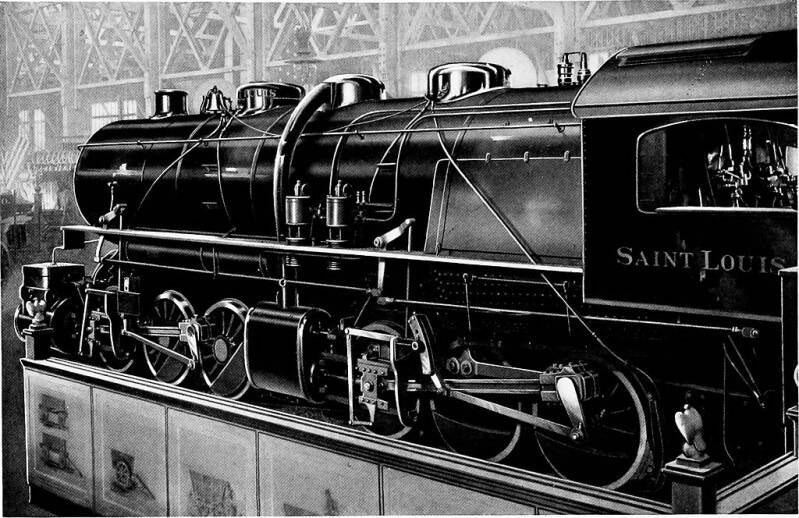Postcard photo of "Old Maude", the Baltimore and Ohio Railroad's mallet locomotive. At the time of the photo,
it was the most powerful locomotive in the world and was the first mallet locomotive in the United States. Circa 1906.
(Baltimore and Ohio Railroad, Public domain, via Wikimedia Commons)
0-6-6-0 ERIE WHEEL ARRANGEMENT
Under the Whyte notation for the classification of steam locomotives, a 0-6-6-0 wheel arrangement refers to a locomotive with two engine units mounted under a rigid locomotive frame, with the front engine unit pivoting and each engine unit with six coupled driving wheels without any leading or trailing wheels. The wheel arrangement was mostly used to describe Mallet locomotive types and in some occasions, Double Fairlie locomotives.
A similar wheel arrangement exists for Double Fairlie, Meyer, Kitson-Meyer and Garratt locomotives, but on these types it is referred to as 0-6-0+0-6-0 since both engine units are pivoting.
Schematic of 0-6-6-0 steam locomotive wheel arrangement. Front of locomotive on left.
(Gwernol, Public domain, via Wikimedia Commons)
Overview
The 0-6-6-0 wheel arrangement was used mostly on Mallet locomotives, on which the engine units were mounted either in tandem or facing each other.
The Westinghouse Companies exhibits at the International Railway Congress, Washington, 1905.
(Internet Archive Book Images, No restrictions, via Wikimedia Commons)
Usage
Canada
The only compound Mallets to operate in Canada were the R1 class 0-6-6-0 Vaughan design locomotives, with the cylinder ends of the engine units facing each other. The class was owned by the Canadian Pacific Railway and served on the Big Hill in British Columbia, which had a 4.1% grade. Five locomotives were built between 1909 and 1911. A sixth one was built, but it was a simple expansion Mallet with two sets of high-pressure cylinders. All the locomotives in this class were later converted to 2-10-0 types and were used as shunting and transfer engines in Montreal.
Mallet articulated (0-6-6-0) Compound Locomotive for Switching Service. Built for New York Central by the American Locomotive Company, 1922.
(Simmons-Boardman, Public domain, via Wikimedia Commons)
United States
The first Mallet locomotive in North America was built in the United States and was of this type, the Baltimore and Ohio Railroad Class O No. 2400. Nicknamed Old Maude after a cartoon mule, it had a 71,500 pounds-force (318 kilonewtons) tractive effort and was a great success despite a top speed of only 21 miles per hour (34 km per hour).
The Kansas City Southern Railway used the type as freight engines, with pilots, and had the most of them with twelve locomotives. The 0-6-6-0 wheel arrangement was also used to a limited extent on logging railroads and in mountain terminals.
The Western Maryland Railway had a small fleet of 2-6-6-2 locomotives which, at one time, were the heaviest locomotives in the world, weighing 264 tons (236 long tons; 239 t). They were all converted to 0-6-6-0 locomotives for heavy switching.
Baltimore & Ohio Mallet locomotive 2400, side view, 1907.
(Andy Dingley (scanner), Public domain, via Wikimedia Commons)
Mexico
Several different types of 0-6-6-0T double-ended Fairlie Tank Locomotives were utilized by Mexican railways (Ferrocarril Mexicano) in the late 1800s.
Double-ended Ferrocarril Mexicano Fairlie Locomotive No. 27, ca. 1890-1899.
(Briquet, Abel, SMU Central University Libraries, No restrictions, via Wikimedia Commons)






